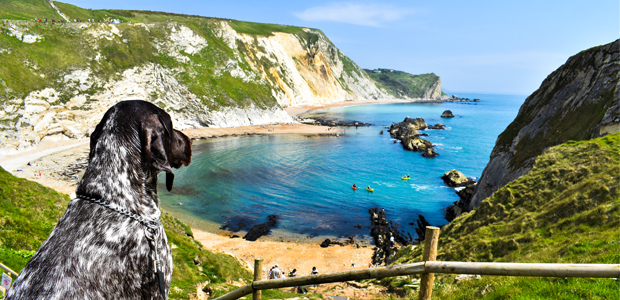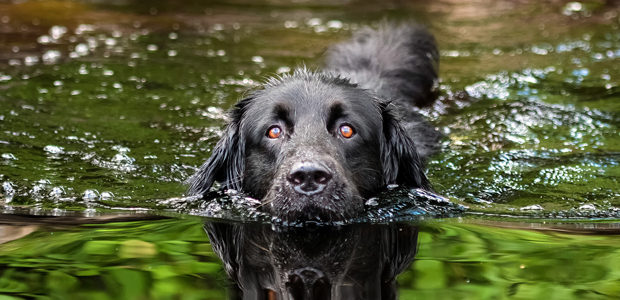Holidays with dogs
What better way to explore the best the UK has to offer than by taking a trip with your dog?
You may not be guaranteed blazing sunshine, but you will get to see this wonderful country with your favourite companion by your side. So with that in mind, here's everything you need to know to have the perfect staycation with your dog.
If you're planning holidays with your dog abroad, read our animal health certificates article.
Packing for holidays with dogs
To ensure you and your dog get the most out of your holiday, ensure you've got everything your dog needs for the duration of your trip. Remember, packing for your pup is more than just a leash and food bowl.
We've put together a helpful checklist of dog travel essentials:
- Water and food bowls
- Poo bags
- A tick twister (and knowledge of how to use it)
- Collar, harness, lead
- Dog food
- Dog first aid kit, including any medication they'll need (waiting for live article to send link)
- A secure seat restraint (dog car seat, dog seat belt, dog car harness or crate. This is a legal requirement)
- Your dog's bed and blankets. Lots of places have strict 'no dogs on the furniture' policies. Bringing your dog's bed will also help them to settle into their new surroundings.
- Dog towel or drying bag (especially if you're heading to the seaside)
- A few of their favourite toys
- Plenty of treats

Check the weather forecast
Even though our weather can be changeable and the forecast isn’t always right, making sure you have an idea of what the weather is likely to do will help you pack right and help you enjoy your dog holidays more. For example, if it's going to be chilly and you have a dog that is susceptible to cold, such as Italian Greyhounds or a senior dog, pack their coat.
Alternatively, if you know it will be warm with the sun shining, ensure you know what temperatures are safe for your dog. Heatstroke can be a killer for dogs. Bring a cool coat or mat, and make sure you have plenty of water at all times. Bring some specialist dog sun cream if your dog has white fur or exposed/pink skin.
Driving with your dog
Not all dogs are comfortable travelling in cars. If your dog isn't used to car travel or is prone to travel sickness, it's a good idea to gradually introduce them to car travel in the weeks leading up to your road trip.
This bedding-in period can help them to become more accustomed to car journeys. It will also give you time to ask your vet any questions you have about travel sickness in dogs. If your dog is anxious about travelling, Vetpro Stress & Anxiety capsules help to calm behaviour in anxious dogs.
When driving with a dog in the car, ensure your dog is safely secured with a dog car seat, dog seat belt, dog car harness or crate. Unsuitable restraints include cardboard boxes, leads (or anything tied around their neck) and holding your dog in your lap. It's also important to place your dog in the back seat. This will keep them safe and help you not get distracted by their puppy dog eyes and wagging tail.
Transporting your pet without a dog car seat, seat belt, harness, or crate can also lead to a fine of up to £2500.
If you're travelling a long way, schedule comfort breaks so your dog can stretch their legs, have a drink and go to the toilet. Many service stations have dog areas where they can get a drink and use the toilet, and if you're travelling particularly far, say from Southern England to Scotland, make sure they have a chance for a longer walk where they can stimulate their mind.
Read More: Driving with dogs: a guide to dog car travel
Get familiar with your surroundings
After packing, preparing, and travelling, it's time to get out and explore your surroundings. When you arrive at your destination, walk your dog around the property or campsite on a lead so they can have a good sniff and take in the new environment.
This will also allow you to look for any hazards, such as ponds and rivers, any gaps your dog could escape through, and sharp objects and ornaments. Simple Google searches will allow you to find out what dog-friendly pubs and eateries there are, what the local laws are regarding off-lead dogs and if there are any places dogs aren't allowed because of ground-nesting birds or wildlife. Getting a map of the local area will help you find the right of ways and byways you can stroll along and explore, helping your dog get used to their new surroundings.
Find out where the nearest vet is just in case something goes wrong. You can use our handy Find a Vet tool to see your nearest My Family Vets practice.

Dog friendly activities to do on holiday
Britain is filled with amazing landscapes, from rolling green hills to sweeping sandy beaches. Here are some of the best places for you and your dog to explore.
Dog friendly beaches
Dogs have a special relationship with the beach. There are few better things to see than happy dogs frolicking in the sea and bounding across the sand. But, while the seaside makes for a great place to take our dogs, there are a few things to consider to ensure they can enjoy the beach safely.
The seas around our glorious coasts are wonderful places to swim. Still, they can hide devastating riptides and strong underwater currents. Ask locals or a lifeguard if an area is safe for swimming, and consider getting your dog a life jacket, especially if they are happy to go paddleboarding or sailing with you.
Avoid heat exhaustion in dogs by taking regular shade breaks and providing plenty of fresh water. Heat stroke can come on quickly and can be fatal for your dog. Signs of heat stroke in dogs include panting, drooling, dizziness & vomiting.
Keep your dog from drinking salt water. Sea water contains lots of salt and can cause chronic dehydration if your dog drinks too much. When a dog ingests excessive amounts of salt, their body will try and correct the imbalance, which can cause dizziness, seizures, confusion and vomiting. If you notice your dog is behaving strangely after a day at the beach, visit your vet immediately.
Watch out for jellyfish, wasps & sharp objects. Jellyfish & wasp stings can cause real discomfort for dogs and can result in a trip to the vet. Sharp objects, such as discarded bottles, can be hard to spot on the beach, so take extra care when taking your dog to the beach.
Some beaches will be dog-friendly year-round, whereas others will have specific dates when your dog isn't allowed. Ensure you find out if your dog is welcome on the beach beforehand. Even if your beach is a year-round dog beach, try not to let your dog chase wildlife, including gulls, and try to keep them away from dead sea life. These carcasses are integral to the beach's ecosystem, and your dog eating or rolling in them can keep natural species away from the area for months.
Read More: Beach safety: taking care of your dog at the beach
Ponds, rivers & canals
Lots of dogs love nothing more than a good paddle. So finding a secluded swimming spot can provide dogs plenty of enrichment and exercise. You could even bring your dog with you as you explore Britain's vast network of canals on a narrowboat trip.
Here are a few things to remember if you and your dog are near our nation's waterways.
Firstly, if you travel along our canal network, keep your dog out of the water. Canal water is not clean and will generally be contaminated with diesel run-off from the narrowboat engines. Also, most canals are busy with two-way traffic, and although narrow boats move slowly, they stop slower. So keep your dog on the deck with you and stop for frequent walks instead.
Blue-green algae is a thick green scum or brown substance found in water that can cause dogs to suffer liver failure and can be fatal in severe cases. There are lots of different types of blue-green algae, so it's best not to take any chances. If the water isn't nice and clean, steer clear.
Leptospirosis is a potentially fatal bacterial infection, primarily spread through the infected urine of rats and other rodents, but can also be found in contaminated water, like puddles, canals, farmlands and stables. Although more common in wetter months, it is a danger year-round and can lead to fever, muscle pain and diarrhoea.
It's easy enough for a dog to jump into the water, but it can be tricky for them to get out, especially in rivers where the banks may be steep and slippery. Dogs can panic when they can't get out of the water, so always check there is an easily accessible exit and be ready to haul them out if needed.
Read More: Blue-green algae poisoning in dogs

Fields & footpaths
What's better than a gentle ramble in the countryside? The UK is home to around 140,000 miles of footpaths, so there are plenty of places to get out and explore with your dog.
Watch out for livestock. Many footpaths pass through fields of cattle, sheep & horses. Although it's ok to walk your dog off lead in public wooded areas, fields and footpaths (provided they are well-trained & have solid recall), it's essential dogs are kept on the lead around livestock.
Electric fences can give dogs a nasty shock, so be sure to keep them at a safe distance. Dogs can become startled if they are shocked and have been known to bolt. This is always a concern, especially if they are in a new or unfamiliar area.
Poisonous plants. Watch out for common flowers such as buttercups, daffodils & tulips. These plants are toxic to dogs and can cause severe symptoms such as nausea, vomiting and seizures. Find out which plants are poisonous to dogs in our detailed article.
Adders are the only poisonous snakes in the UK, and although they rarely bite dogs or humans, adder bites are more common than you might think. Adder bite symptoms include lethargy, vomiting & swelling of the affected area. If you suspect your dog has been bitten by an adder, contact your vet immediately.
Read More: What to do if your dog has an adder bite
Make sure your dog is suitable for the activities
Make sure the activities you undertake are suitable for your dog. For example, if you want to hike the Cairngorms or walk the Pennine Way and have a Bichon Frise, it may be best to leave them at home. But if you have a Border Collie or Labrador Retriever, they may want to keep going long after you've ordered your first pint.
Understanding what your dog is capable of will be an integral part of making your holiday successful. If they are anxious around crowds or don't like cyclists, you'll have to consider that when planning your holiday.
If you do your research, prepare your dog and have a plan B, then you'll have a brilliant time exploring these beautiful Isles with your best friend by your side.

Need more info?
For more information on travelling with your dog or any other aspect of your dog’s health and well-being, have a chat with your vet. Find your nearest vet using our Find a Vet page.
.jpg?ext=.jpg)



